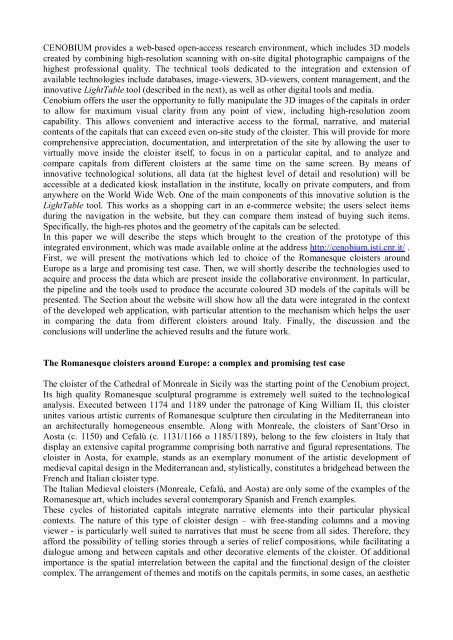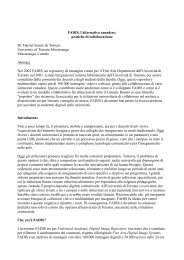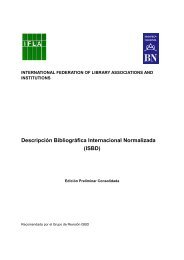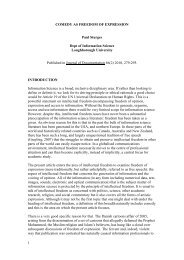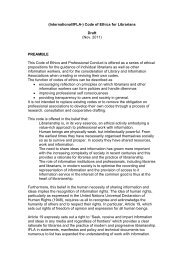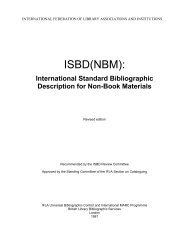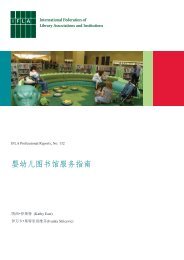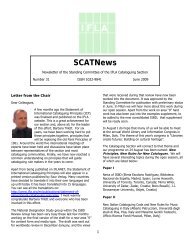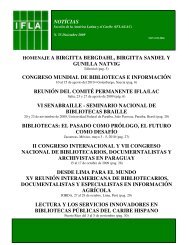CENOBIUM â Putting together the Romanesque Cloister ... - IFLA
CENOBIUM â Putting together the Romanesque Cloister ... - IFLA
CENOBIUM â Putting together the Romanesque Cloister ... - IFLA
You also want an ePaper? Increase the reach of your titles
YUMPU automatically turns print PDFs into web optimized ePapers that Google loves.
<strong>CENOBIUM</strong> provides a web-based open-access research environment, which includes 3D models<br />
created by combining high-resolution scanning with on-site digital photographic campaigns of <strong>the</strong><br />
highest professional quality. The technical tools dedicated to <strong>the</strong> integration and extension of<br />
available technologies include databases, image-viewers, 3D-viewers, content management, and <strong>the</strong><br />
innovative LightTable tool (described in <strong>the</strong> next), as well as o<strong>the</strong>r digital tools and media.<br />
Cenobium offers <strong>the</strong> user <strong>the</strong> opportunity to fully manipulate <strong>the</strong> 3D images of <strong>the</strong> capitals in order<br />
to allow for maximum visual clarity from any point of view, including high-resolution zoom<br />
capability. This allows convenient and interactive access to <strong>the</strong> formal, narrative, and material<br />
contents of <strong>the</strong> capitals that can exceed even on-site study of <strong>the</strong> cloister. This will provide for more<br />
comprehensive appreciation, documentation, and interpretation of <strong>the</strong> site by allowing <strong>the</strong> user to<br />
virtually move inside <strong>the</strong> cloister itself, to focus in on a particular capital, and to analyze and<br />
compare capitals from different cloisters at <strong>the</strong> same time on <strong>the</strong> same screen. By means of<br />
innovative technological solutions, all data (at <strong>the</strong> highest level of detail and resolution) will be<br />
accessible at a dedicated kiosk installation in <strong>the</strong> institute, locally on private computers, and from<br />
anywhere on <strong>the</strong> World Wide Web. One of <strong>the</strong> main components of this innovative solution is <strong>the</strong><br />
LightTable tool. This works as a shopping cart in an e-commerce website; <strong>the</strong> users select items<br />
during <strong>the</strong> navigation in <strong>the</strong> website, but <strong>the</strong>y can compare <strong>the</strong>m instead of buying such items.<br />
Specifically, <strong>the</strong> high-res photos and <strong>the</strong> geometry of <strong>the</strong> capitals can be selected.<br />
In this paper we will describe <strong>the</strong> steps which brought to <strong>the</strong> creation of <strong>the</strong> prototype of this<br />
integrated environment, which was made available online at <strong>the</strong> address http://cenobium.isti.cnr.it/ .<br />
First, we will present <strong>the</strong> motivations which led to choice of <strong>the</strong> <strong>Romanesque</strong> cloisters around<br />
Europe as a large and promising test case. Then, we will shortly describe <strong>the</strong> technologies used to<br />
acquire and process <strong>the</strong> data which are present inside <strong>the</strong> collaborative environment. In particular,<br />
<strong>the</strong> pipeline and <strong>the</strong> tools used to produce <strong>the</strong> accurate coloured 3D models of <strong>the</strong> capitals will be<br />
presented. The Section about <strong>the</strong> website will show how all <strong>the</strong> data were integrated in <strong>the</strong> context<br />
of <strong>the</strong> developed web application, with particular attention to <strong>the</strong> mechanism which helps <strong>the</strong> user<br />
in comparing <strong>the</strong> data from different cloisters around Italy. Finally, <strong>the</strong> discussion and <strong>the</strong><br />
conclusions will underline <strong>the</strong> achieved results and <strong>the</strong> future work.<br />
The <strong>Romanesque</strong> cloisters around Europe: a complex and promising test case<br />
The cloister of <strong>the</strong> Ca<strong>the</strong>dral of Monreale in Sicily was <strong>the</strong> starting point of <strong>the</strong> Cenobium project.<br />
Its high quality <strong>Romanesque</strong> sculptural programme is extremely well suited to <strong>the</strong> technological<br />
analysis. Executed between 1174 and 1189 under <strong>the</strong> patronage of King William II, this cloister<br />
unites various artistic currents of <strong>Romanesque</strong> sculpture <strong>the</strong>n circulating in <strong>the</strong> Mediterranean into<br />
an architecturally homogeneous ensemble. Along with Monreale, <strong>the</strong> cloisters of Sant’Orso in<br />
Aosta (c. 1150) and Cefalù (c. 1131/1166 o 1185/1189), belong to <strong>the</strong> few cloisters in Italy that<br />
display an extensive capital programme comprising both narrative and figural representations. The<br />
cloister in Aosta, for example, stands as an exemplary monument of <strong>the</strong> artistic development of<br />
medieval capital design in <strong>the</strong> Mediterranean and, stylistically, constitutes a bridgehead between <strong>the</strong><br />
French and Italian cloister type.<br />
The Italian Medieval cloisters (Monreale, Cefalú, and Aosta) are only some of <strong>the</strong> examples of <strong>the</strong><br />
<strong>Romanesque</strong> art, which includes several contemporary Spanish and French examples.<br />
These cycles of historiated capitals integrate narrative elements into <strong>the</strong>ir particular physical<br />
contexts. The nature of this type of cloister design – with free-standing columns and a moving<br />
viewer - is particularly well suited to narratives that must be scene from all sides. Therefore, <strong>the</strong>y<br />
afford <strong>the</strong> possibility of telling stories through a series of relief compositions, while facilitating a<br />
dialogue among and between capitals and o<strong>the</strong>r decorative elements of <strong>the</strong> cloister. Of additional<br />
importance is <strong>the</strong> spatial interrelation between <strong>the</strong> capital and <strong>the</strong> functional design of <strong>the</strong> cloister<br />
complex. The arrangement of <strong>the</strong>mes and motifs on <strong>the</strong> capitals permits, in some cases, an aes<strong>the</strong>tic


